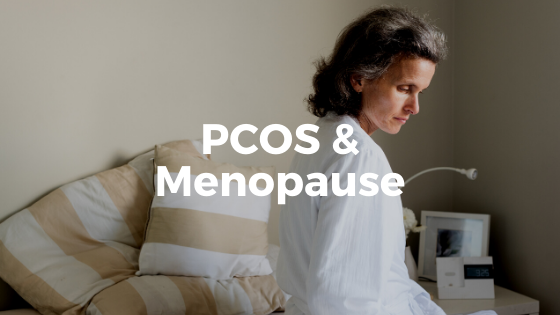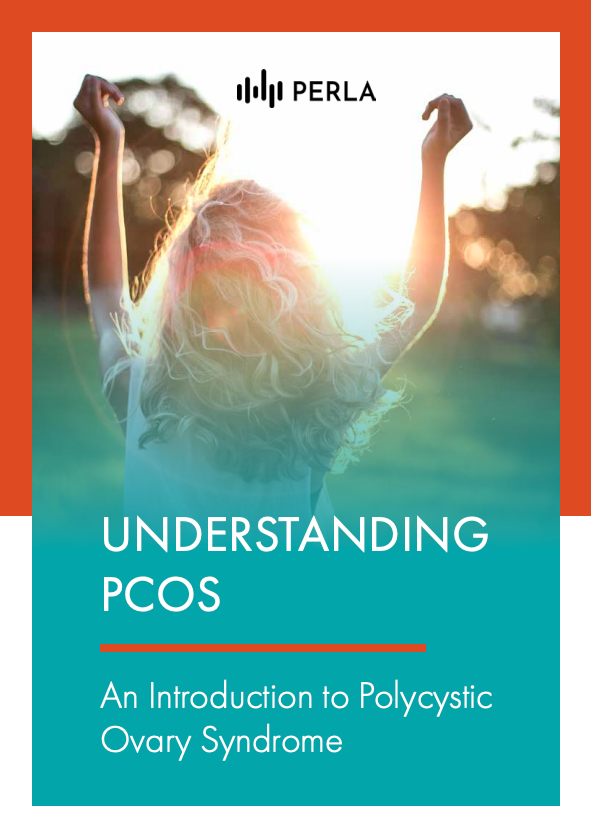Menopause is a natural event in every woman’s life characterized by the end of her menstrual cycles due to hormonal changes. Polycystic ovary syndrome (PCOS) is a common hormone disorder in women that can cause symptoms such as irregular periods, weight gain, excess hair growth (hirsutism), and infertility. Many people believe that menopause can cure PCOS. But is this really the case? Here we’ll discuss the link between PCOS and menopause.
The Role of Hormones
Both PCOS and menopause are associated with changes in sex hormones. Most notable is the increased levels of testosterone in PCOS and the fluctuating levels of estrogen in women approaching menopause.
These hormonal changes influence not just your reproductive health but your physical and mental health and well-being. For instance, estrogen protects your heart by helping to raise your HDL levels (the good kind of cholesterol).1 It also protects you from bone loss by working with calcium and other minerals to build bone.2 Osteoporosis can occur when estrogen levels start to decline because your body doesn’t make more bone than it breaks down.
Additionally, changes in sex hormones cause symptoms. Women with PCOS often suffer from excess facial and body hair (hirsutism), acne, male-pattern hair loss, and irregular periods. They are also prone to weight gain or obesity, insulin resistance, or diabetes. Menopausal symptoms on the other side include hot flashes, night sweats, insomnia, joint pains, mood changes, weight gain, and vaginal dryness.
Menopause Defined
The average age for menopause is 51 years. For most women, it could occur between ages 50 and 55. Menopause starts when the ovaries stop producing mature eggs, and androgen levels begin to decline. Once you stop having menstrual periods for 12 months, it means you have reached the milestone and now entering the postmenopausal stage.3
Stages of Menopause:
- Perimenopause: Menopause transition is the medical term used to describe this stage. This typically begins about 8 to 10 years before the natural menopause. You are still menstruating and can get pregnant during perimenopause. You may experience menopause symptoms such as hot flashes, sleep problems, and vaginal dryness.
- Menopause: Defined as 12 consecutive months of not having periods, which reflects a natural decrease of ovarian function.
- Postmenopause: The years following menopause. During this stage, menopause symptoms usually ease for most women. However, low levels of estrogen can put women at increased risk for osteoporosis, vaginal and bladder changes, and heart disease.
Does PCOS Change After Menopause?
1. Menopause does not cure PCOS
It is a common misconception that PCOS goes away once a woman enters menopause. Unfortunately, this is not the case here. Circulating androgens gradually decrease with age. But this does not necessarily mean that your PCOS will disappear.
Between 20 and 40 years, testosterone levels in healthy women could decrease by 50%.4 A study found that the decrease was slower in women with PCOS. Androgen levels did not reduce to normal until 20 years after menopause.5 This is why you can continue to experience PCOS symptoms even if you are no longer menstruating.
While testosterone levels may no longer be higher after menopause than in control women, other androgen levels such as DHEA, DHEA-S, androstenedione, and androstenediol remains higher,6,7,8 or may even rise during the menopausal transition.9
2. Menopause may come later in women with PCOS
PCOS can delay menopause by 2 to 4 years.10,11 But not only that; studies show that in women with PCOS, menstrual cycles might be more frequent toward the end of the reproductive years.12,13
It appears that Anti-Müllerian hormone (AMH) and androgens play a role. While an abnormally high level of AMH may indicate PCOS, it is also a good predictor of your ovarian reserve.14 The AMH test evaluates how many potential eggs remain in your ovaries. A low level can mean you are starting menopause or may have trouble conceiving.
3. Hyperandrogenism persists in postmenopausal women with PCOS
As women enter menopause, androgen levels are known to remain stable or even to increase while estrogen levels decrease dramatically. The prolonged exposure to hyperandrogenism worsens health risks associated with PCOS and menopause. You should watch out for insulin resistance, chronic inflammation, dyslipidemia, and obesity as they tend to persist or worsen after menopause.15
Conclusion
Contrary to what many people believe, research says that PCOS does persist after menopause. Menopause and the change in hormone it causes is associated with an increase in body fat, particularly abdominal fat. This excess weight is linked to an increased risk of metabolic disturbances and heart disease, which is magnified by the presence of PCOS. It is key to work with your PCOS care team to set up a monitoring program for these long-term complications.
And even if you’re not approaching menopause for a while, it’s a good idea to already plan ahead and look into how to reduce your risk later in life through lifestyle modifications and monitoring for future complications.
Sources:
- Cleveland Clinic. “Estrogen & The Heart.” Cleveland Clinic, Apr. 2019, my.clevelandclinic.org/health/articles/16979-estrogen–hormones. Accessed 20 Jan. 2021.
- Kalervo Väänänen, H., and Pirkko L. Härkönen. “Estrogen and Bone Metabolism.” Maturitas, vol. 23, May 1996, pp. S65–S69, www.maturitas.org/article/0378-5122(96)01015-8/pdf, 10.1016/0378-5122(96)01015-8. Accessed 16 Aug. 2019.
- Harvard Health Publishing. “Menopause.” Harvard Health, www.health.harvard.edu/topics/menopause. Accessed 20 Jan. 2021.
- Morley, J. E., and H. M. Perry. “Androgens and Women at the Menopause and Beyond.” The Journals of Gerontology Series A: Biological Sciences and Medical Sciences, vol. 58, no. 5, 1 May 2003, pp. M409–M416, 10.1093/gerona/58.5.m409. Accessed 20 Jan. 2021.
- Schmidt, Johanna, et al. “Reproductive Hormone Levels and Anthropometry in Postmenopausal Women with Polycystic Ovary Syndrome (PCOS): A 21-Year Follow-Up Study of Women Diagnosed with PCOS around 50 Years Ago and Their Age-Matched Controls.” The Journal of Clinical Endocrinology & Metabolism, vol. 96, no. 7, 1 July 2011, pp. 2178–2185, 10.1210/jc.2010-2959. Accessed 19 Oct. 2020.
- Alsamarai S, Adams JM, Murphy MK, et al. Criteria for polycystic ovarian morphology in polycystic ovary syndrome as a function of age. J Clin Endocrinol Metab. 2009;94:4961– 4970.
- Schmidt J, Brännström M, Landin-Wilhelmsen K, Dahlgren E. Reproductive hormone levels and anthropometry in postmenopausal women with polycystic ovary syndrome (PCOS): a 21-year follow-up study of women diagnosed with PCOS around 50 years ago and their age-matched controls. J Clin Endocrinol Metab. 2011;96: 2178 –2185.
- Puurunen J, Piltonen T, Morin-Papunen L, et al. Unfavorable hormonal, metabolic, and inflammatory alterations persist after menopause in women with PCOS. J Clin Endocrinol Metab. 2011;96: 1827–1834.
- Lasley BL, Crawford S, McConnell DS. Adrenal androgens and the menopausal transition. Obstet Gynecol Clin North Am. 2011;38(3):467-475. doi:10.1016/j.ogc.2011.06.001
- Tehrani, Fahimeh Ramezani, et al. “Is Polycystic Ovary Syndrome an Exception for Reproductive Aging?” Human Reproduction (Oxford, England), vol. 25, no. 7, 1 July 2010, pp. 1775–1781, pubmed.ncbi.nlm.nih.gov/20435693/, 10.1093/humrep/deq088. Accessed 20 Jan. 2021.
- Forslund, Maria, et al. “Higher Menopausal Age but No Differences in Parity in Women with Polycystic Ovary Syndrome Compared with Controls.” Acta Obstetricia et Gynecologica Scandinavica, vol. 98, no. 3, 15 Nov. 2018, pp. 320–326, 10.1111/aogs.13489. Accessed 20 Jan. 2021.
- Brown ZA, Louwers YV, Fong SL, et al. The phenotype of polycystic ovary syndrome ameliorates with aging. Fertil Steril 2011; 96: 1259–1265.
- Elting MW, Kwee J, Korsen TJ, et al. Aging women with polycystic ovary syndrome who achieve regular menstrual cycles have a smaller follicle cohort than those who continue to have irregular cycles. Fertil Steril 2003; 79: 1154–1160.
- Dumont, Agathe, et al. “Role of Anti-Müllerian Hormone in Pathophysiology, Diagnosis and Treatment of Polycystic Ovary Syndrome: A Review.” Reproductive Biology and Endocrinology, vol. 13, no. 1, Dec. 2015, www.ncbi.nlm.nih.gov/pmc/articles/PMC4687350/, 10.1186/s12958-015-0134-9. Accessed 1 Feb. 2019.
- Puurunen, Johanna, et al. “Unfavorable Hormonal, Metabolic, and Inflammatory Alterations Persist after Menopause in Women with PCOS.” The Journal of Clinical Endocrinology & Metabolism, vol. 96, no. 6, June 2011, pp. 1827–1834, 10.1210/jc.2011-0039.


